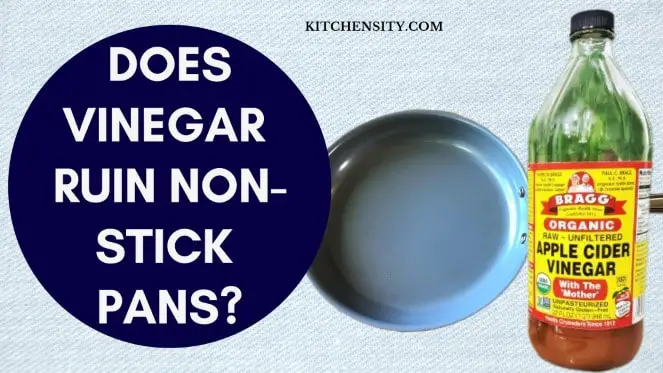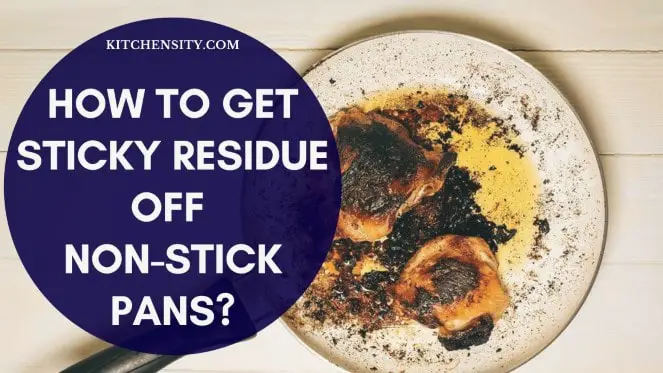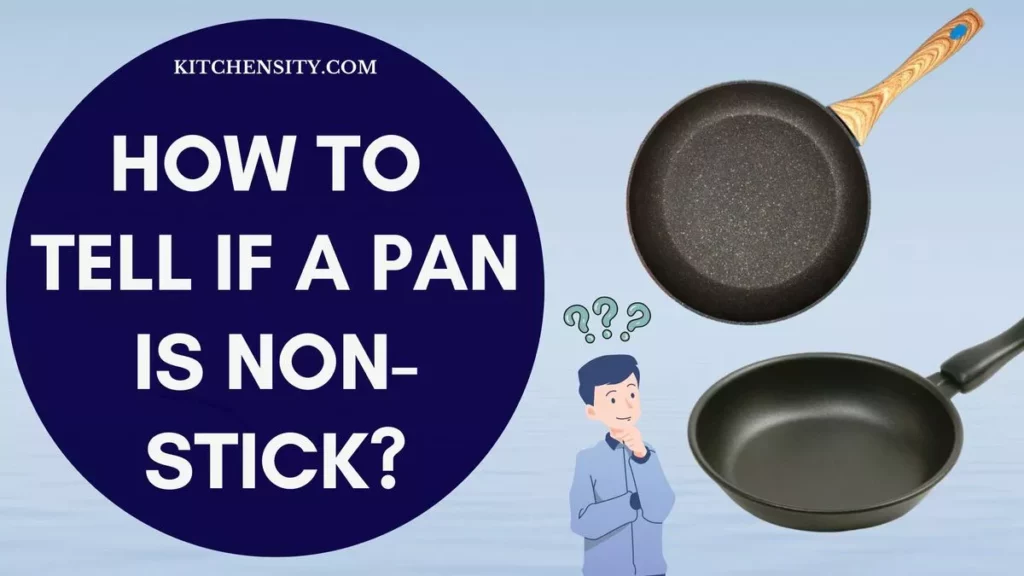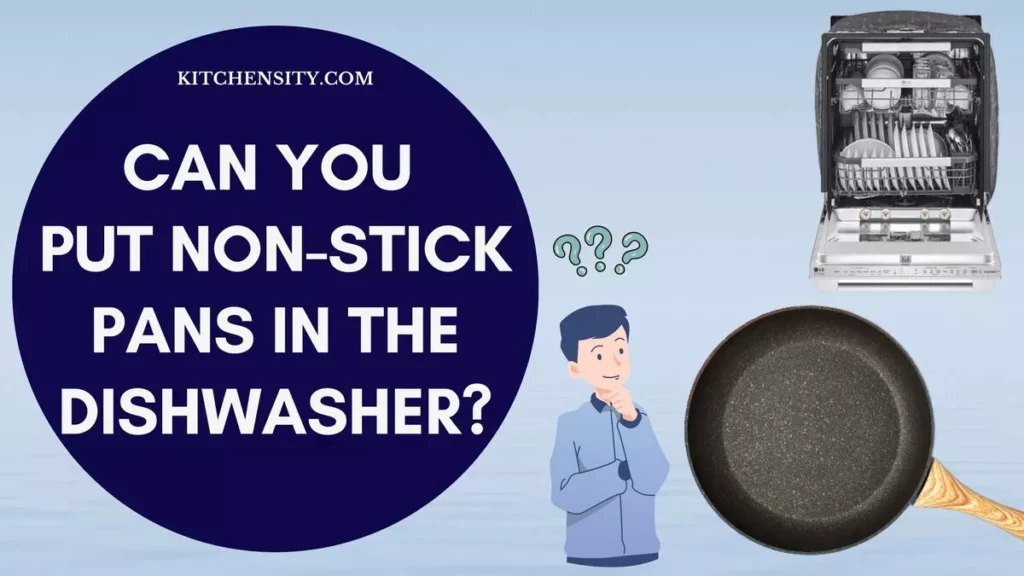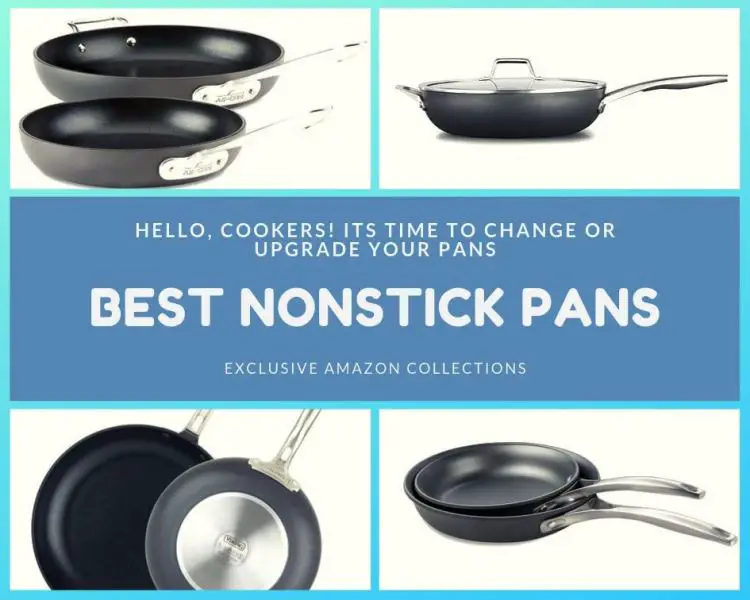Outdoor cooking can be a delightful experience, whether you’re camping, picnicking, or simply enjoying a meal in your backyard. Using non-stick pans outdoors requires special care to ensure they remain in top condition and continue to provide reliable performance.
In this article, you’ll explore the best practices for caring for non-stick pans outdoors, including some tips for preparation, cooking, cleaning, and storage.
Table of Contents
- 1 Caring Tips For Non-Stick Pans Using Outdoors.
- 2 How To Choose The Right Non-Stick Pan For Outdoor Use?
- 3 How To Prepare Your Non-Stick Pan For Outdoor Cooking?
- 4 How To Cook With Your Non-Stick Pan Outdoors?
- 5 How To Clean Your Non-Stick Pan After Use?
- 6 How Does Outdoor Cooking Affect Non-Stick Pans Differently Than Indoor Cooking?
- 7 Are There Specific Types Of Non-Stick Pans Designed For Outdoor Use?
- 8 Can Non-Stick Pans Be Used On Open Flames Or Over A Campfire?
- 9 How To Maintain Non-Stick Properties Over Time When Used Outdoors?
- 10 Washing Non-Stick Pans While Hot: Can We Do It?
- 11 Final Thoughts: How To Care For Non-Stick Pans When Used Outdoors?
- 12 FAQs (Frequently Asked Questions)
Caring Tips For Non-Stick Pans Using Outdoors.
Using non-stick pans outdoors can be a convenient way to prepare meals while enjoying the great outdoors. However, outdoor cooking can present unique challenges for non-stick pans due to exposure to elements like heat, open flames, and rough surfaces. Proper care is essential to ensure that your non-stick pans remain in good condition and continue to provide reliable performance. Here’s how to care for your non-stick pans when used outdoors.
- Start by selecting non-stick pans specifically designed for outdoor or camping use. These pans are durable and feature reinforced non-stick coatings that withstand outdoor cooking.
- Before using your non-stick pan outdoors, it’s important to prepare it properly. Clean the pan thoroughly with mild soap and water to remove dust, dirt, or residue. Dry the pan completely to prevent water from splattering when it comes into contact with hot oil or food.
- Seasoning your non-stick pan before each outdoor use can help enhance its non-stick properties and prolong its lifespan. To season the pan, apply a thin layer of cooking oil to the interior surface and heat it over a low flame for a few minutes. Once the oil starts to smoke lightly, remove the pan from the heat and wipe off any excess oil with a paper towel. Your pan is now seasoned and ready for use.
- When cooking with non-stick pans outdoors, use utensils that won’t scratch or damage the non-stick coating. Opt for silicone, wooden, or plastic utensils instead of metal ones. Avoid using sharp or abrasive objects that can scratch the pan’s surface.
- After cooking outdoors, allow the non-stick pan to cool down before cleaning. Use a soft sponge or cloth with mild soap and water to gently clean the interior and exterior surfaces of the pan. Avoid using abrasive cleaners or scrubbing pads that can scratch the surface. Rinse the pan thoroughly with clean water and dry it completely before storing.
- Proper storage is essential for maintaining the non-stick properties of your pans. Store them in a cool, dry place away from direct sunlight or heat sources. Avoid stacking other items on top of the pans, as this can cause damage to the non-stick coating.
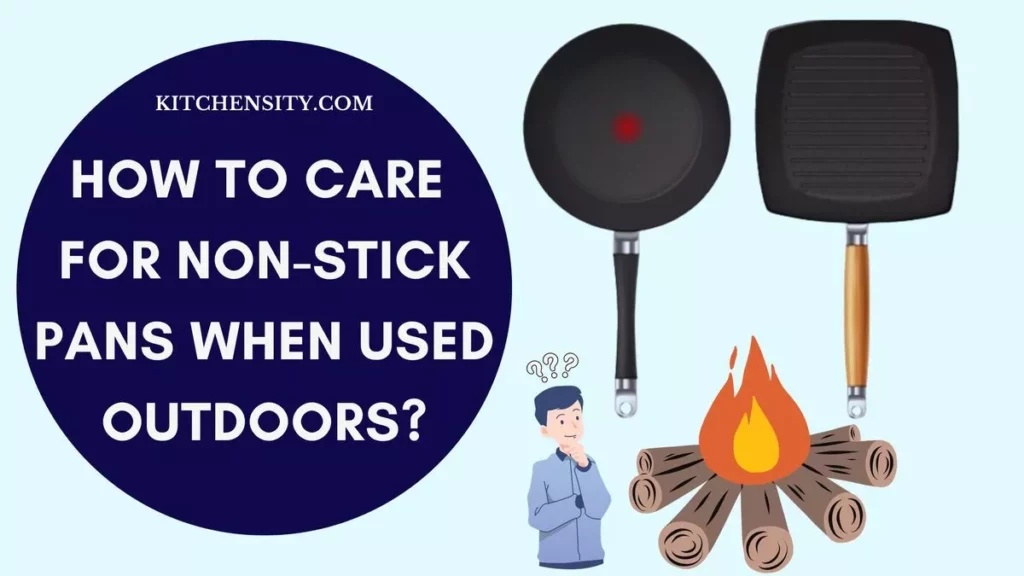
Also Read – Can You Use Non-Stick Cookware On High Heat?
How To Choose The Right Non-Stick Pan For Outdoor Use?
To choose the right non-stick pan for outdoor use, consider several key factors.
- First, look for pans made from durable materials like hard-anodized aluminum or stainless steel, as these are lightweight and heat-resistant.
- Next, check the quality of the non-stick coating, ensuring it is PFOA-free and scratch-resistant for longevity.
- Consider the size and weight of the pan, opting for one that suits your cooking needs and is easy to handle outdoors.
- Ensure the pan is compatible with outdoor cooking equipment, such as camping stoves or grills.
- Also, look for pans that are easy to maintain and clean, preferably dishwasher-safe.
- Lastly, consider the overall portability of the pan for convenience during outdoor cooking adventures.
Also Read – How To Use A Non-Stick Pan For The First Time?
How To Prepare Your Non-Stick Pan For Outdoor Cooking?
To prepare your non-stick pan for outdoor cooking, follow these steps:
- Clean the Pan: Ensure the pan is clean and free from debris or residue. Use warm, soapy water and a soft sponge to gently clean the pan. Avoid using abrasive cleaners or scouring pads that could damage the non-stick coating.
- Dry the Pan: Thoroughly dry the pan with a clean cloth to remove any moisture. This helps prevent rusting and ensures even heating during cooking.
- Season the Pan (Optional): If your non-stick pan is made of cast iron or carbon steel, consider seasoning it before use. Seasoning helps create a natural, non-stick surface and enhances the pan’s durability.
- Preheat the Pan: Before cooking, preheat the pan on a moderate heat setting for a few minutes. This helps ensure even heating and prevents food from sticking to the surface.
- Apply Cooking Oil: Once the pan is preheated, apply a thin layer of cooking oil to the cooking surface. Use a brush or paper towel to spread the oil evenly. This helps create a barrier between the food and the pan, further preventing sticking.
Also Read – Are Non-Stick Coatings Safe For Cooking?
How To Cook With Your Non-Stick Pan Outdoors?
After preparing your non-stick pan for outdoor cooking, you can proceed with your cooking process. Here are the next steps:
- Place the pan on your outdoor cooking equipment, such as a camping stove or grill, and cook your food as desired. Use utensils made of silicone, wood, or plastic to avoid scratching the non-stick coating.
- Keep an eye on the heat level to prevent overheating, as excessive heat can damage the non-stick coating. Use a moderate heat setting for best results.
- Continue to use utensils that are safe for non-stick surfaces, such as silicone, wood, or plastic, to avoid scratching the coating.
- After cooking, let the pan cool down before cleaning. Use warm, soapy water and a soft sponge to gently clean the pan. Avoid using abrasive cleaners or scouring pads.
- Thoroughly dry the pan with a clean, dry cloth and store it in a cool, dry place. Avoid stacking heavy items on top of the pan to prevent damage to the non-stick coating.
Also Read – Types Of Non-Stick Coatings
How To Clean Your Non-Stick Pan After Use?
To clean your non-stick pan after use, follow these steps:
- Allow the pan to cool down completely before cleaning to avoid warping or damaging the non-stick coating.
- Fill the pan with warm water and add a small amount of mild dish soap.
- Let the pan soak for a few minutes to loosen any stuck-on food. Use a soft sponge or cloth to gently scrub the surface. Avoid using abrasive cleaners or scouring pads, as they can damage the non-stick coating.
- Rinse the pan thoroughly with warm water to remove any soap residue.
- Use a clean, dry cloth to thoroughly dry the pan. Avoid air-drying, as this can lead to water spots and potential rusting.
- Store the pan in a cool, dry place. Avoid stacking heavy items on top of the pan to prevent damage to the non-stick coating.
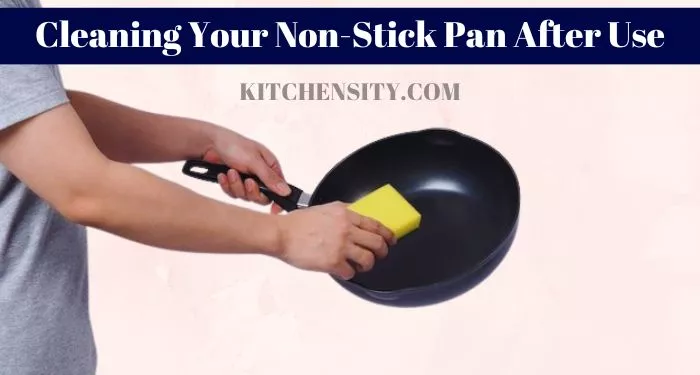
Also Read – How To Extend The Lifespan Of Non-Stick Pans?
How Does Outdoor Cooking Affect Non-Stick Pans Differently Than Indoor Cooking?
Outdoor cooking can impact non-stick pans differently compared to indoor cooking, mainly due to factors such as heat levels, environmental exposure, handling, and cleaning challenges. Outdoor cooking equipment, like camping stoves or grills, may generate higher heat than indoor stovetops, potentially damaging the non-stick coating over time. Exposure to outdoor elements like wind, rain, and dust can affect the pan’s performance and durability, requiring more frequent cleaning and maintenance.
Outdoor cooking surfaces, such as campfire grates or portable stoves, may not provide as even heating as indoor stovetops, leading to hot spots that could impact the non-stick coating. Cleaning non-stick pans used outdoors can be more challenging, especially without access to running water or cleaning supplies. Improper cleaning techniques can further damage the coating.
To mitigate these effects, it’s crucial to choose a high-quality non-stick pan designed for outdoor use, follow proper cooking and cleaning practices, and ensure the pan is stored correctly when not in use.
Also Read – Things To Look For When Buying Non-Stick Cookware
Here’s a comparison table outlining how outdoor cooking can affect non-stick pans differently than indoor cooking.
| Aspects | Outdoor Cooking Impact | Indoor Cooking Impact |
| Heat Source Variability | A wide range of heat sources (e.g., campfires, portable stoves) may provide less consistent or controlled heat. | Typically more consistent heat from stovetops allows for better control over cooking temperature. |
| Exposure to Elements | Exposure to outdoor elements like wind, rain, and dust may affect pan conditions if not properly cared for. | A sheltered environment indoors minimizes exposure to external elements, reducing the impact on pan conditions. |
| Physical Stress | May experience more physical stress from being carried outdoors or exposed to rough surfaces, leading to potential scratches or damage. | Generally less physical stress as pans are used and stored in controlled indoor environments. |
| Cleaning Challenges | Limited access to water and cleaning supplies outdoors may make cleaning more challenging, especially with outdoor debris. | Typically easier access to water and cleaning supplies indoors simplifies the cleaning process. |
| Storage Considerations | Outdoor storage may expose pans to temperature fluctuations and moisture, potentially affecting the non-stick coating. | Indoor storage provides a more stable environment, reducing the risk of damage from temperature and moisture. |
Also Read – Can You Deep Fry In A Non-Stick Pan?
Are There Specific Types Of Non-Stick Pans Designed For Outdoor Use?
Yes, there are specific types of non-stick pans designed for outdoor use. These pans are typically made from durable materials such as hard-anodized aluminum or stainless steel, which are lightweight and heat-resistant, making them ideal for outdoor cooking. They often feature a high-quality non-stick coating that is PFOA-free and scratch-resistant, ensuring durability and performance in outdoor environments.
Outdoor non-stick pans may also have features such as heat-resistant handles, which are essential for safe handling over open flames or on hot surfaces. Some outdoor non-stick pans are designed to be compatible with camping stoves or grills, with features that make them easy to use and clean in outdoor settings.
Also Read – Best Non-Stick Cookware Brands
Can Non-Stick Pans Be Used On Open Flames Or Over A Campfire?
Non-stick pans should not be used directly on open flames or over a campfire. The high heat from open flames can exceed the safe temperature range for non-stick coatings, causing them to break down and release harmful chemicals. Also, the intense heat can damage the pan’s non-stick surface, reducing its effectiveness and lifespan.
Instead, if you want to use a non-stick pan for outdoor cooking over a campfire or open flame, it’s recommended to use a heat diffuser or a grill grate to create a more even cooking surface. Place the pan on top of the diffuser or grate to protect it from direct contact with the flames and reduce the risk of overheating.
Also Read – How To Fix Scratched Non-Stick Pans?
How To Maintain Non-Stick Properties Over Time When Used Outdoors?
To maintain the non-stick properties of cookware when used outdoors, follow these tips.
- First, avoid using it directly on open flames or over a campfire, as it can damage the non-stick coating. Instead, use moderate heat settings to prevent overheating.
- Second, use utensils made of silicone, wood, or plastic to avoid scratching the non-stick surface.
- Third, clean the cookware gently with a soft sponge or cloth and mild detergent. Avoid abrasive cleaners or scouring pads, as they can damage the non-stick coating.
- Finally, store the cookware carefully in a cool, dry place to prevent damage to the non-stick surface.
Following these tips can help maintain the non-stick properties of cookware when used outdoors, ensuring it remains effective and long-lasting.
Also Read – How To Get Sticky Residue Off Non-Stick Pans?
What Should I Do If My Non-Stick Pan Gets Damaged During Outdoor Cooking?
If your non-stick pan gets damaged during outdoor cooking, there are several steps you can take to assess the damage and potentially address it.
- First, inspect the pan to assess the extent of the damage. Look for scratches, chips, or signs of wear on the non-stick coating. Determine if the damage is minor or if it significantly affects the pan’s performance.
- If the damage is significant and affects the pan’s non-stick properties, it’s best to stop using the pan to prevent further deterioration and potential health hazards from the damaged coating.
- If the pan is still under warranty or if you believe the damage occurred due to a manufacturing defect, contact the manufacturer for guidance. They may offer repair or replacement options depending on the warranty terms and the nature of the damage.
- Depending on the type and extent of the damage, you may be able to repair the pan yourself using a non-stick repair kit. These kits typically include materials to patch up minor damage to the non-stick coating.
- If the damage is extensive and affects the pan’s usability, it may be necessary to replace the pan. Look for a high-quality replacement that is suitable for outdoor use and follow proper care and maintenance practices to prevent similar damage in the future.
Also Read – How To Remove The Non-Stick Coating From Cookware?
Washing Non-Stick Pans While Hot: Can We Do It?
Washing non-stick pans while they are still hot is generally not recommended. Non-stick coatings are designed to be used at moderate temperatures, and exposing them to sudden temperature changes, such as adding cold water to a hot pan, can potentially damage the coating.
When a non-stick pan is heated, its metal expands, and the non-stick coating becomes more susceptible to damage from abrasive scrubbing or sudden temperature changes. Washing a hot non-stick pan with cold water can cause thermal shock, which may lead to warping or cracking of the pan’s surface. Also, rapid cooling can cause the non-stick coating to lose its effectiveness over time.
To avoid damaging your non-stick pans, it’s best to let them cool down to a safe temperature before washing them. This allows the pan to return to its normal state, reducing the risk of damage to the non-stick coating. Once the pan has cooled, you can safely wash it with warm, soapy water using a soft sponge or cloth. Avoid using abrasive cleaners or scrubbing pads, as these can scratch the non-stick surface.
Final Thoughts: How To Care For Non-Stick Pans When Used Outdoors?
So, caring for non-stick pans when used outdoors is essential to maintain their performance and longevity. By choosing the right pans, preparing them properly, and using them with care during outdoor cooking, you can ensure that they remain in top condition.
Seasoning the non-stick surface before each use, using gentle utensils, and cleaning the pans thoroughly after use are crucial steps. Proper storage is also important to prevent damage. By following these guidelines, you can enjoy the convenience of non-stick pans for many outdoor cooking adventures to come.
Also Read – What To Look For When Buying Non-Stick Cookware?
FAQs (Frequently Asked Questions)
-
Can I Use My Regular Non-Stick Pans For Outdoor Cooking?
While you can use regular non-stick pans outdoors, it’s best to use pans specifically designed for outdoor use. These pans are often more durable and better suited to withstand outdoor cooking conditions.
-
How Should I Clean My Non-Stick Pans After Outdoor Use?
After outdoor use, clean your non-stick pans with mild soap and water using a soft sponge or cloth. Avoid abrasive cleaners or scrubbing pads that can damage the non-stick coating.
-
How Can I Prevent My Non-Stick Pans From Getting Damaged During Outdoor Cooking?
To prevent damage, avoid using metal utensils that can scratch the non-stick coating. Use moderate heat settings and avoid sudden temperature changes, such as placing a hot pan in cold water.
Katrina Smith is a seasoned expert with over 25 years of experience in all things related to cooking and the kitchen. As an avid cook and kitchen enthusiast, she is passionate about sharing her knowledge and expertise on cookware, kitchen appliances, kitchen tips, and kitchen staples.
Through her articles and reviews, Katrina aims to inspire and help others improve their cooking skills, experiment with different ingredients, and invest in quality cookware and appliances.


